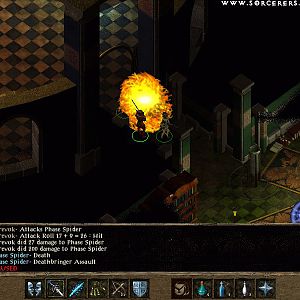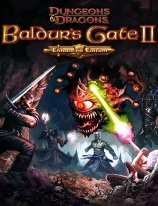-

- Forums
- Chatrooms
- Gallery
- Gameplay Videos
- Upload
- Articles
- Mod Reviews
- Shop SP: Games, Movies, Books

| The
Lord of the Rings: The Two Towers,
Reviewed by Falstaff |
Yes, Director Peter Jackson distorted the plot of the book in a few instances. I knew this would happen, even before seeing the first movie in this most-anticipated trilogy. That is what happens when a book of such scope and magnitude is made into a film. And although Jackson has taken a few more liberties in the second movie, the experience of seeing this epic tale on the big screen is not lessened for it. And most of the adjustments are understandable.
First and most importantly: Gollum. From the few short snippets that are seen of him in Fellowship, I knew that Gollum would be wonderfully done, but I had no idea of how wonderful it could be.
This is no normal CG creation. This is an actual CG character, with a performance that is as convincing and memorable as the performances of any other member of the cast. Andy Serkis did not just provide the voice, but created an entire character: his face is frighteningly similar to the rendered Gollum, and his body movements and physical performance were the models for the animation team. Some of the most memorable scenes of the movie will be the Smeagol/Gollum conversations, where voice acting and animation combine to create two distinct characters with the same face.
Oh yeah, and the CG looked really good too. The combination of live-action and CG is immaculate, even down to a cloak on the ground getting caught between Gollum’s toes in his initial scuffle with Frodo and Sam. There is nothing on the screen that would make one believe that Gollum is not actually there – the environment reacts to him, Frodo and Sam react exactly as they should when touched by him, and the rendering is of such quality that you actually want to believe that the emaciated, frog-like creature actually was on the set. And the number of different facial expressions that Gollum has is seemingly unending. In the year of CG characters (such as Dobby the House-Elf and Yoda), Gollum certainly takes top marks.
On to the rest of the (as expected) wonderful casting.
Bernard Hill plays the troubled King of Rohan, Theoden, perfectly. His performances across the screen from Ian McKellan and Viggo Mortensen are dramatic and compelling. Hill is goes from feeble and bewitched to powerful and wrathful and then to sad and distraught with convincing ease.
Miranda Otto joins the cast as Eowyn, sister of Eomer, played by Karl Urban. Both of these actors make fine additions to the movie. Otto’s Eowyn is stunningly beautiful and yet has the fiery essence of this woman who refuses to be trapped in a society led by men. Urban’s Eomer is also as proud as expected, and although he interacts with the other characters less than in the book (although Jackson still has him bandying words with Gimli), he is a faithful portrayal nonetheless.
The big surprise was Brad Dourif, who plays Theoden’s treacherous counselor, Grima Wormtounge, as if it was second nature to him. Dourif’s portrayal is delightfully slimy and venomous, and his screen time with Otto and the others is time well spent. The sniveling servant of Saruman has practically leapt off of the pages of Tolkien’s book and into the arms of Dourif, who certainly knows how to treat him.
The most liberty was taken with the character of Faramir, played by David Wenham. Wenham does not get a lot of screen time, but if the previews for the extended editions are any clue, that will be remedied in November. Wenham does do a good job with this minor character, presenting his conflicted thoughts about the ring and its bearer well in the short time allotted to him.
Although Jackson sends Faramir and the Hobbits to Osgiliath, he does so with good reason: most of the scenes in the book that involve Faramir are purely dialogue, with little or no action or movement. Jackson needed to tell more about the character, but obviously did not want to spend time with lengthy and boring conversations about Faramir’s relationship with his brother and father. Although a rather large departure from the book, it is one well spent, and certainly does not detract from the story at all.
The final new member of the cast is an old member of the cast. John Rhys-Davies provides the voice (and face) for Treebeard the Ent. I must say, Jackson’s Ents look much better than anything I had ever pictured while reading the books. Although many memorable scenes are cut from Fangorn Forest, Treebeard and the other Ents are well-created enough to make up for it, and the flooding of Isengard is nothing short of exciting. Another good job from the effects team.
The sets and landscapes here are marvelous. Meduseld and the rest of Edoras are beautifully built, and Helm’s Deep is incredible. New Zealand has provided Jackson with some truly wonderful landscapes to work with, and he uses them to his best effort.
This movie is long, and has so many new and wonderful things in it that it is hard to say everything about it at one time or for any extended length, so I shall conclude with a number of shorter remarks.
The opening battle sequence between Gandalf and the Balrog is exciting, and just one more example of the wonderful work of the effects team that Jackson has working for him.
The Mumakil/Oliphaunt: Wow. That is all I can say. Wow.
Frodo/Sam/Gollum: These scenes were great. Not too long and not too short, Jackson gives plenty of time to set up not only Frodo’s growing concern with the ring, but also Sam’s concern with Frodo without making the scenes overly long and stilted, as he could have done. We can only watch the three of them walk around for so long without getting bored.
The Battle of Helm’s Deep. This battle was so big, it is hard to imagine how Jackson and co. will be able to tackle the Battle of Pelennor Fields and make it bigger and even more spectacular. The battle was huge without being overwhelming, but still about as epic as has ever been seen on the big screen. Also, I am not sure why Jackson decided to send Elves to the Deep, but I am glad he did, because the company of archers was something spectacular to see.
The Warg Riders. Yet again. Wow. I had always imagined wargs to be smaller and more wolf-like, but I am glad that the design team did not – the hyena/bear/wolf hybrid beasts were just plain nasty.
The Fell Beasts. I never did get a good mental picture of these creatures while reading the books, so this was something that I was curious to see. Although the scene where Frodo stands practically nose-to-nose with one of the Nazgul’s steeds was a bit strange, overall, the creatures were really cool. And huge, very, very huge.
Voice-overs. Strangely, the thing I noticed most about this movie is the rather large amount of voice-overs during the movie. I am not a big fan of voice-overs, but Jackson uses them well here. Galadriel, Elrond, Gandalf, even Sam all have rather long and drawn out monologues, during which we are given nice montages of things going on in Middle Earth. An old device used rather well, I must say.
Jackson’s Adjustments. First of all, the movie ends nowhere near where the books do. That is good, however, because in truth, not much happens in the novel of The Return of the King. I am glad Jackson saved something for his third movie besides a battle and a long, drawn-out resolution. It was also nice to see more of Arwen – Tolkien never gave her much time in the book, and left much of the relationship between Aragorn and Arwen up to the imagination. The near-drowning of Aragorn was strange, but also worked well to set up even more the love that Eowyn has for him, as well as to show his importance to the others in the movie. My only complaint to Jackson would be his abuse of Gimli. Although much of his comic relief was not only funny but also necessary to break up the tense moments of the film, Gimli could have been given a few more serious moments (especially during the battle) to even out the character. Gimli kicked a lot of orc butt in the book, and I missed this in the movie. As for Shelob, we will just have to wait until December.
Overall, I think Jackson did a good job of putting together a movie made from a book that takes place in three different locations at the same time without being too choppy in doing so. Die-hard fans of the book will certainly complain, but that does not take away from the fantastic job done by the filmmakers here. Another memorable episode in the trilogy that started modern fantasy fiction, and may restart modern fantasy fimmaking.


